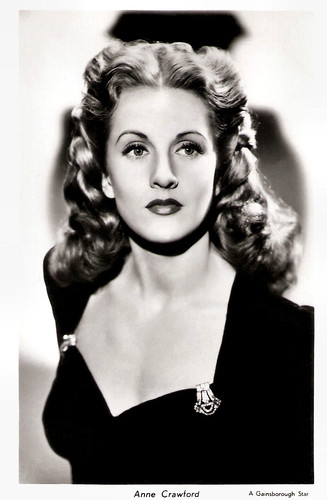
British postcard in the Picturegoer Series, London, no. W 153. Photo: Gainsborough.

British postcard in the Picturegoer Series, London, no. W 866. Photo: Pinnacle Prod.

British postcard by Real Photographs Company Ltd, Southport. Photo: Gainsborough.
Posh, selfish but basically a good sort
Anne Crawford was born in 1920 in Haifa, Palestine (now Israel) as Imelda Anne Crawford. She was the child of an English mother and a Scottish father, who worked as a paymaster for the Palestine Railway. The family returned to Britain when she was 7 years old. Raised in Edinburgh, she went to school at St. Margret's convent in Marchmont.
Afterwards, she studied drama in Edinburgh and at the Royal Academy of Dramatic Arts (RADA) in London. Her professional career started at a repertory theatre in Manchester where she soon was playing juvenile leads.
She changed her name from Imelda to Anne. She had a tiny role in Prison Without Bars (Brian Desmond Hurst, 1938) with Corinne Luchaire and Edna Best, and a better role in They Flew Alone (Herbert Wilcox, 1942) starring Anna Neagle.
It was the smash hit Millions Like Us (Frank Launder, Sydney Gilliat, 1943) that crystallised her star persona: posh, selfish but basically a good sort. During her career, there were a few attempts to get away from this template, notably her poor mill worker in Master of Banksdam (Walter Forde, 1947) with Dennis Price.
During the war, she also appeared in such women's pictures as Two Thousand Women (Frank Launder, 1944) with Phyllis Calvert and Flora Robson, and They Were Sisters (Arthur Crabtree, 1945) with James Mason.

British autograph card.

Belgian postcard by P.E. (Photo Edition, Brussels), no. 572. Photo: Gaumont / Eagle-Lion.
One of the most startling British films of the 1940s
After the war, Anne Crawford became known for the wild Gainsborough melodrama Caravan (Arthur Crabtree, 1946) starring Stewart Granger and Jean Kent, and the classic horror film Daughter of Darkness (Lance Comfort, 1948).
In his Guide to British Cinema, Geoff Mayer writes, "Daughter of Darkness, with a budget of two hundred thousand pounds and three weeks of location shooting in Cornwall, was not a financial success and represented a setback to Comfort's career, which saw him relegated to low-budget films in the 1950s and 1960s. Yet the film's mixture of gothic and horror establishes it as one of the most startling British films of the 1940s."
In 1953 she starred as Morgan Le Fay in Knights of the Round Table (Richard Thorpe, 1953), with Robert Taylor and Ava Gardner. She made her West End debut in 1949 in 'Western Wind' at the Piccadilly Theatre, followed by a not-very-successful stint on Broadway in 1951 in 'The Green Bay Tree'. Her television career ran in parallel to her film career, and in 1955 she topped a viewer's poll for her performance in the BBC teleplay The Leader of the House (Douglas Allen, 1955).
Anne Crawford died in 1956 in London of leukaemia. She was only 35. At the time of her death, she was appearing in the Agatha Christie play 'The Spider's Web', at the Savoy Theatre, London. Co-stars Margaret Lockwood, Patrick Barr, and Ronald Howard attended her funeral. Her resting place is the Kensal Green Cemetery.
Crawford was married to James Hartley (1939-?) and stage and television producer/director Wallace Douglas (1953-1956). David Absalom at British Pictures: "For modern audiences, Crawford's perceived poshness can seem a bit distancing, and it's hard to judge how her career would have panned out had she not died so early. I suspect she would have done okay. She showed enough wit and timing in her few comedy outings and there was always something of the grande dame about her to suggest that she would have only improved with age."

Dutch postcard by Hemo. Photo: Eagle Lion.

British autograph card. Photo: Gainsborough.
Sources: David Absalom (British Pictures), Fritz Tauber (Find A Grave), Wikipedia, and IMDb.
This post was last updated on 6 November 2023.
No comments:
Post a Comment